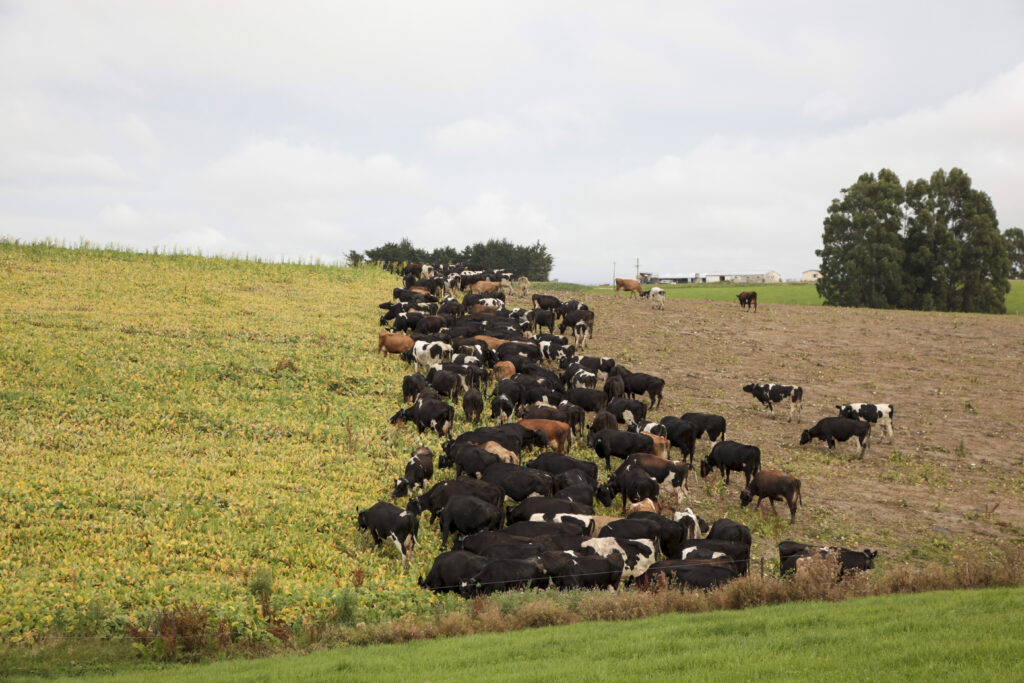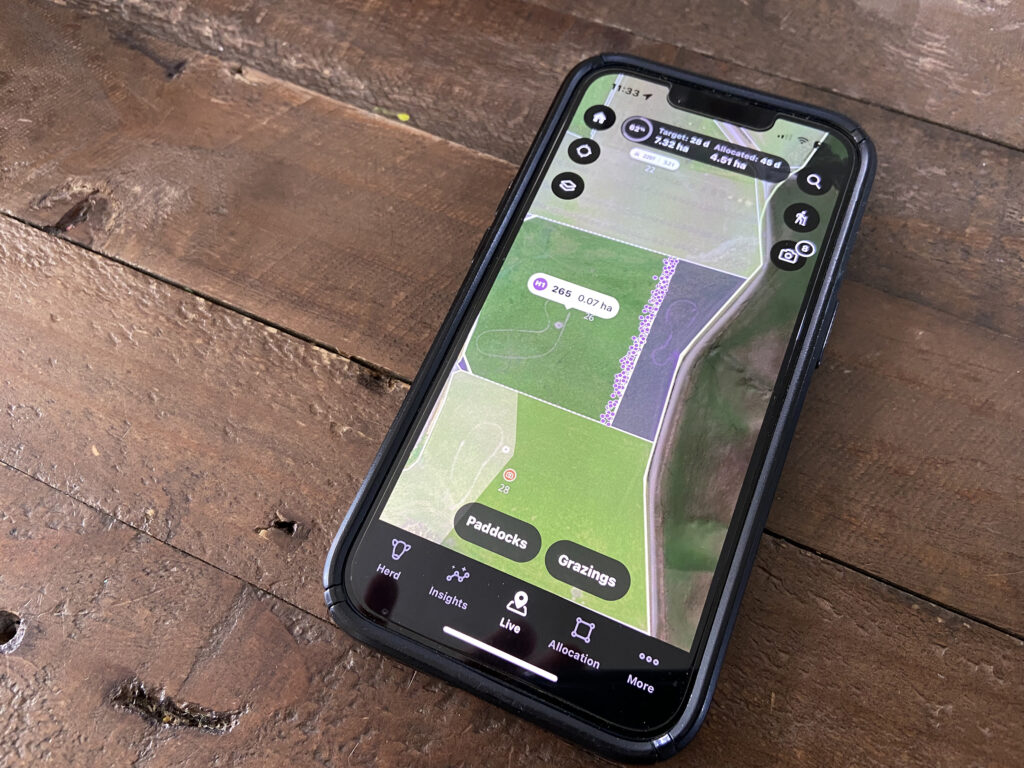The rolling geography of Kayne Smith’s Southland farm was one of his biggest challenges, but it has now become his biggest opportunity.
Smith’s farm is 300 hectares effective, with a 200ha milking platform and 100ha used as run-off including 26ha of winter crops.
He runs a 50-bale rotary shed, with cup removers, in-shed feeding and Protrack, milking 600 cows at peak.
The farm uses supplementary feed throughout summer and winter, growing 14ha of summer crop and feeding it out 3kg-4kg a day for 60 days. The 26ha of winter crop is fed out at a 50% baleage and 50% crop mix in the colder months.
Smith is in a 50% equity partnership set up by ANZ in 2019 with now-retired Bruce and Sue Cunningham, who live in Queenstown.
The farm is long and skinny, with the furthest paddock a 3km walk from the 50-bale rotary shed.
The length and the rolling hills of the farm present challenges and have to be managed, Smith says.
Though the furthest paddocks are mostly used to grow baleage, a few times a year cows have to walk 6km for a single milking.
For safety’s sake, and probably to make life easier, fences on the heavy rolling hills were not put up in exactly the right spot for optimum pasture use, he says.
“We were putting the fence in the easier spot, rather than the exact spot.”
The farm always had potential but needed something extra to push it to its best production, he says.
He had been asking Halter to come to Southland for some time, he says. He wanted to put Halter’s virtual fencing to the test not only to maximise pasture utilisation, but also because he could reduce staff numbers and stay ahead of the game when it came to technological developments in the dairy industry.
With those goals in mind, and the farm’s geography also in the mix, 18 months ago he fitted Halter collars to 600 milking cows.
“When we first signed up most of our friends thought we were crazy. They thought we would not recoup the cost,” Smith says.
“We did a few figures and could not say if we would be able to. But now we’re confident we will.”
Bringing in Halter meant an immediate savings of $55,000 as Smith could cut one casual labour unit.

“It kept us as a small team of three – but a very good team of three.”
Smith is the co-owner and manager, Regan Smith is the 2IC and Phillip Balicuit is the herd manager. Both Balicuit and Regan have been with Kayne for five years.
Smith’s farm consultant, Alex Hunter, was also initially hesitant about Halter.
But a recent farm review changed his mind after he saw how much extra pasture they grew and used.
“He redid the figures, he thought it wasn’t right. He is now a proponent of Halter,” Smith says.
Data from Halter shows Smith was not feeding as accurately as he could have – and might have been either over or underfeeding by as much as 2kg dry matter per cow per day.
Halter’s newest update, Pasture Pro, combines machine learning, weather data, satellite imagery and computer vision to produce an accurate map of pasture use.
It then uses virtual fencing to set breaks so that cows eat exactly what they need.
“Now our feeding is changing every single day. In the past we’d measure once a week, even paying someone $12,000 per year to do it. There’s an immediate cross through that cost,” Smith says.
Halter says longstanding industry research shows a 1cm error above target residual equals a 16% drop in utilisation.
As an example, a cow grazing a ryegrass paddock half a leaf early means a 12.5% reduction in total yield.
Inefficiencies from conventional farming practices compound significantly over a season, costing a 500-cow farm $90,000 worth of lost production.
Smith now simply inputs that he wants to feed cows 20kg dry matter per day and uses the software as a tool to set accurate breaks accordingly.
The gains have been phenomenal, he says.
In the 2021/22 season the farm grew 15.4tDM/ha.
Halter was fitted to cows three months into the 2022/23 season, and the farm has since grown 17.2tDM/ha.
That translated into a lift of 24,657kgMS on the previous season’s production, which totalled 249,319kg MS for a total of 273,976kgMS for 2022/23.
Smith says due to low cow numbers and slow calving last season, he has a target of 274,000kgMS this season.
“We have a large target next season of 285,000kgMS. We had a good in-calf rate this season, which in turn means we will try peak milk 630 plus cows.”
Besides precise calculation of feed, Smith can also set the residual he wants for a paddock.
In the past, Smith has had to deal with cows pushing through fences and last winter was the first time there was no breakout.
Smith attributes this to cows now eating exactly the right amount of feed they need to stay warm and grow a healthy calf, where previously, when it was cold or windy, cows ate to keep warm first.
When weather is an issue, cows can now simply be moved to a sheltered part of a paddock via the Halter app, even if Smith has kicked off his gumboots for the day and is at home spending time with the family.
The main change on the farm that brought about the leap in improvements is Halter, he says.
“We’ve owned the farm for five years, there’s been a small gain every single year. But then we’ve got this big jump in one season.”
Smith says with the farm being more productive and lucrative, he has more financial and lifestyle options.
“I’m young. I want to build my equity and pay off debt. I also love the outdoors. If I’m not working I’m outdoors doing something else. Now that we’ve got four kids we want to create options for them.
“We didn’t come from a farming family background. But now we see the life it gives us, we want to give our kids that option,” he says.
Staffing hours have also been cut considerably.
“I had to work through mating and be there every single day for eight weeks. Now I can have a sleep-in every second day if I want, because the information is there for a junior farm assistant to make the same decisions that I would.
“The staff used to get one sleep-in in a week. Now they get one every second day, that’s because the cows are bringing themselves to the shed. One person milks and somebody sleeps in. Staff morale is well up.”
Smith believes they can produce even more milk but has not yet increased cow numbers to capitalise on the extra pasture.
“We are definitely also up on milk solids per cow”.
“We wrapped and stacked the extra pasture. We’ve put about an extra 150 tonnes of silage into the silage stack. And an extra 300 bales of baleage. There’s also more grass shut up. We’ve always eaten every single blade of grass, we haven’t had that surplus.”
Rounds lengths are now also longer, he says.

In the past, 27 days was standard, but now “early thirties” is common, without having to move cows after teatime, he says.
This was achievable using all the information Halter gave him.
“We simply set how many kilos per cow we want. That’s it.”
Fertiliser use on the farm will change in future.
“We’ve got a heat map now and know where the cows are camping and doing most of their natural fertilising. Our plan is to reduce fertiliser inputs on those areas.”
A challenge to solve will be precision application of fertiliser as he uses a bulk fertiliser.
There is the potential of using his own fertiliser spreader in future, he says.
“There’s two ways to look at it. Do we add the same inputs and hopefully grow a lot more grass? Or do we work out what’s going to make the most profit for us?”
Calving starts on August 8, and he rears 150 replacement heifer calves that are weaned at 90kg.
All of the calves are inside on woodchip for the first month of their lives, then put out into fresh grass paddocks with shelter belts onto a tow-behind feeder. They then receive 2L of fresh milk twice a day for five days, then 5L once a day until close to weaning.
Milk is then reduced, and meals upped over a two-week period.
“It’s an easy system that works with low staff hours needed. We breed strong easy-care animals.”
In future Smith aims to put Halter collars on 150 rising one-year-olds, in the hope that his pasture utilisation improves even more and that he can create more runoff.
“We’re going to have to make more baleage and put more cows on, which in return will hopefully give us more profit.”
Mating starts on October 31 with all milking cows and rising two-year-old cattle artificially inseminated with bulls but out from December 25 to January 7.
“The system is easy for staff. It’s a one-man farm over the holiday period so everyone can enjoy it.”
Smith uses CRV for genetics and uses Friesian straws over crossbreed cows and Kiwicross straws over the Friesians.
“We aim for a good Friesian cross cow that has a live weight of 500kg. We want an easy-care animal that can grass our hilly terrain and utilise the pasture that grows on it.
“We also progeny test straws for CRV. We enjoy seeing some of the up-and-coming bulls in their system. Progeny testing keeps us excited and hopefully getting that early genetic gains.”
Another big change is how Smith sees individual cows.
“We are not looking at cows as a whole mob anymore because we have data for individuals. Rather than ask why a mob’s rumination is down, we can ask why a single cow’s rumination is down and address that,” he says.
“Lameness has halved since we started using Halter. We used to have four lame-cow paddocks. We use only two now and turned the other two into milking-cow paddocks. We never knew we were pushing cows hard when we moved them with bikes,” he says.
Smith says if he considers the gains that happened on the farm in 18 months, he can foresee that massive changes will happen on the farm in the next few years.
Beyond looking to get the farm to optimum production, Smith says growing his team is important, with the aim of equipping 2IC Regan and herd manager Balicuit in their journeys to move up and onto other farms.
This article first appeared in our sister publication, Dairy Farmer.










